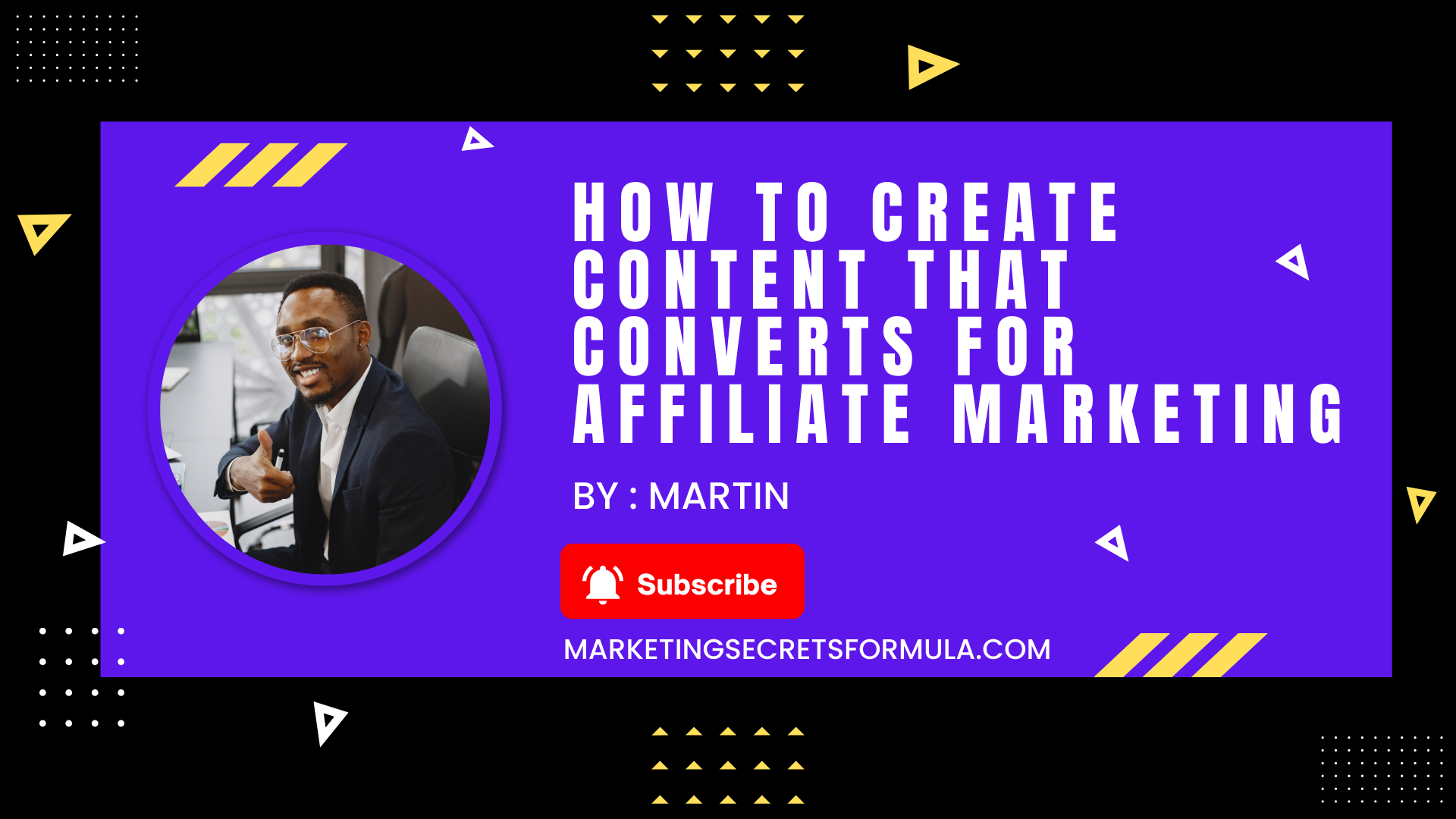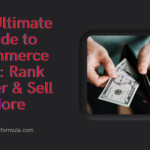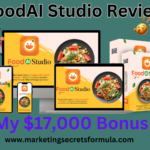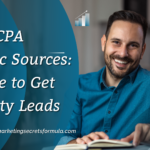Welcome to my article “How to Create Content That Converts for Affiliate Marketing” Affiliate marketing sounds like a dream gig, doesn’t it? You recommend a few products, sprinkle some links in your content, and watch the commissions roll in while sipping coffee in your pajamas. But here’s the catch: if your content doesn’t grab attention, build trust, and persuade readers to click that shiny affiliate link, your dreams of passive income might remain just that—dreams.
Creating content that converts is both an art and a science. You can’t just slap together a few sentences, toss in some affiliate links, and call it a day. Think of it like baking a cake: if you don’t have the right ingredients (valuable information, a pinch of persuasion, and a dash of SEO), you’ll end up with a lopsided mess instead of a delicious masterpiece. And let’s be honest—no one’s going to buy a cake that looks like it survived an earthquake.
In this guide, we’ll dive into the nitty-gritty of crafting content that doesn’t just inform but inspires action. Whether you’re writing product reviews, tutorials, or listicles, I’ll show you how to keep your audience hooked, win their trust, and gently nudge them toward hitting that “Buy Now” button. By the end, you’ll have a recipe for success that’ll make your affiliate earnings rise faster than bread in a warm oven. Ready to roll up your sleeves and get to work? Let’s create some content magic!
Access My Proven Tested Formula for $50-$100 Daily Income – Watch This FREE Video Now >>>
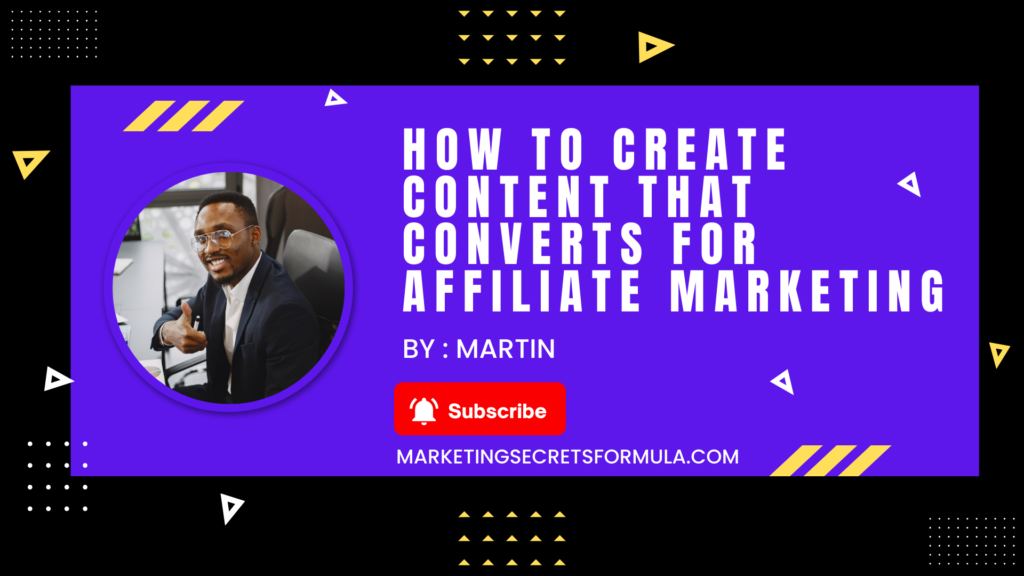
Understanding Your Audience’s Needs and Pain Points
If you want your affiliate marketing content to convert, you’ve got to think like a mind reader—or at least a really good detective. Understanding your audience’s needs and pain points isn’t just a nice-to-have; it’s the secret sauce that transforms your content from “meh” to “take my money!” After all, if you don’t know what keeps your readers up at night, how can you convince them that the product you’re promoting is the answer to their prayers?
Start by getting up close and personal with your audience (not in a creepy way, of course). Who are they? What do they care about? What are their challenges, frustrations, and burning questions? Tools like Google Analytics and social media insights can give you a goldmine of data about your readers—what they search for, what content they love, and what makes them click away faster than you can say “affiliate commission.”
But don’t stop there! Think of yourself as a friendly online therapist—ask questions, start conversations, and really listen to what your audience has to say. Polls, surveys, and even good old-fashioned comment sections are fantastic ways to uncover their biggest struggles. If your readers are constantly asking how to get better sleep, and you’re busy recommending espresso machines, you’ve got a problem (and so do they).
Once you’ve nailed down your audience’s pain points, it’s time to create content that feels like it was tailor-made just for them. Address their concerns head-on, offer actionable solutions, and don’t be afraid to inject a little empathy into your writing. Remember, people don’t just want to feel understood—they want to know you’ve got their back. And when your content delivers that magic combination of understanding and value, your audience will not only trust you but also happily follow your recommendations. Voilà—conversion gold!
Choosing the Right Affiliate Products to Promote
Let’s get one thing straight: not all affiliate products are created equal. Some are the marketing equivalent of a five-star restaurant meal, while others are a soggy microwave burrito that no one asked for. If you want your content to convert, you need to be picky—like, “Marie Kondo your affiliate links” picky. Promoting the right products isn’t just about slapping a link onto your blog post; it’s about finding items that resonate with your audience and genuinely solve their problems.
The first rule of thumb? Know your niche like the back of your hand. If your blog is all about fitness, recommending an ergonomic office chair might leave your readers scratching their heads (and you wondering why no one’s clicking). Instead, focus on products that align with your content and address your audience’s specific needs. For instance, a protein powder that tastes like dessert or a smartwatch that tracks every step, heartbeat, and calorie burned could be a perfect fit.
Next, do your homework—because nothing kills credibility faster than promoting a dud. Research product reviews, ratings, and testimonials. Better yet, try the product yourself if you can. Not only will this give you firsthand insights to share, but it also makes your content feel authentic. Trust me, your readers can smell fake enthusiasm from a mile away.
Access My Proven Tested Formula for $50-$100 Daily Income – Watch This FREE Video Now >>>
And here’s the kicker: don’t get blinded by high commission rates. Sure, a fat payout is tempting, but if the product isn’t valuable or relevant to your audience, those commissions will stay hypothetical. Instead, aim for the sweet spot—products that offer a decent payout and make your readers’ lives better. Remember, happy readers are loyal readers, and loyal readers are more likely to convert.
So, before you hit “publish” on that next affiliate post, ask yourself: Does this product align with my audience? Does it add value to their lives? And, most importantly, does it pass the “Would I recommend this to my best friend?” test? If the answer is yes, you’ve got yourself a winner. If not, toss it out like last week’s leftovers and keep searching. Your readers—and your bank account—will thank you.
Crafting Attention-Grabbing Headlines and Introductions
Let’s face it: the internet is a noisy place. People are bombarded with so much content daily that your carefully written article can easily get lost in the shuffle. Enter the dynamic duo of headlines and introductions—the ultimate gatekeepers of your content. If your headline doesn’t stop the scroll, your audience won’t even glance at your intro. And if your intro is duller than a Monday morning meeting, they’ll click away faster than you can say “affiliate commission.”
The secret to a killer headline? Make it impossible to ignore. Think of it as the bait on your fishing hook—it needs to be irresistible. Use numbers (“5 Easy Steps to Double Your Income”), curiosity-driven phrases (“The Secret to Better Sleep No One Tells You”), or solutions to problems your audience cares about (“How to Lose Weight Without Giving Up Pizza”). Sprinkle in a little SEO magic by including keywords, but don’t overdo it. You’re writing for humans, not robots, and no one wants to click on a headline that reads like a poorly translated instruction manual.
Now that your headline has done its job and reeled them in, your introduction has to seal the deal. Start with a bang—a statistic that shocks, a question that intrigues, or a relatable scenario that makes your readers go, “Oh, that’s so me!” For example, “Do you ever feel like your affiliate links are gathering more dust than your high school yearbook? Don’t worry, we’ve all been there.” Your intro is where you connect with your audience and give them a reason to keep reading.
But don’t just dazzle them—deliver on the promise your headline made. Let your readers know exactly what they’ll get out of the article and why it’s worth their time. And remember, a touch of humor or personality goes a long way. No one’s ever complained about a chuckle while learning how to boost their affiliate earnings. Nail your headline and intro, and you’ve already won half the battle for your readers’ attention. The rest? That’s where your awesome content comes in.
Writing Persuasive and Value-Driven Content
If your content is a sales pitch disguised as a blog post, your readers will smell it a mile away—and trust me, they’ll run for the hills. Writing persuasive and value-driven content isn’t about shoving affiliate links down your audience’s throat; it’s about offering them something genuinely helpful while gently guiding them toward your recommendations. Think of it like being a friendly tour guide, not a pushy used car salesperson.
The first step? Provide real value. Your readers came to your content for a reason—they have a problem, a question, or a curiosity they want addressed. Your job is to solve that problem or answer that question in a way that’s clear, actionable, and genuinely useful. Let’s say you’re writing about the best noise-canceling headphones. Instead of just saying, “Buy this, it’s great,” dig deeper. Highlight the product’s benefits, explain how it works, and even share a personal story about how it saved your sanity during a long flight. The more value you provide, the more your readers will trust you—and trust is the currency of affiliate marketing.
Access My Proven Tested Formula for $50-$100 Daily Income – Watch This FREE Video Now >>>
Next, sprinkle in a little persuasion—but keep it subtle. Use social proof (“This product has over 5,000 five-star reviews”), urgency (“Limited-time discount available”), or comparisons (“It’s half the price of other models but just as effective”). Show your readers why the product is worth their attention without making it feel like you’re twisting their arm. And don’t be afraid to address potential objections head-on. If a product has a minor drawback, acknowledge it and explain why the benefits outweigh it. Transparency builds credibility, and credible content converts.
Finally, make your call-to-action (CTA) feel like a natural conclusion, not a hard sell. Instead of “Click here to buy now,” try something like, “If you’re ready to upgrade your work-from-home setup, this could be the game-changer you’ve been looking for.” The goal is to make your readers feel like they’re making an informed decision, not getting talked into something they don’t need.
When you focus on helping rather than selling, your content transforms into a resource your audience actually wants to engage with. And when your readers see the value in what you’re sharing, clicking on that affiliate link becomes the obvious next step—no arm-twisting required.
Optimizing Content for SEO and Conversions
Let’s be real: you could write the most brilliant, engaging, and persuasive content in the universe, but if no one can find it, it’s like throwing a party and forgetting to send out invitations. That’s where SEO comes in. But hold on—it’s not just about ranking high on Google. Your content also needs to convert once people actually land on your page. Striking the right balance between SEO and conversions is like juggling: tricky but oh-so-rewarding when you nail it.
First, let’s tackle SEO. Start by picking the right keywords—ones your audience is actively searching for. Tools like Google Keyword Planner or SEMrush are your best friends here. Focus on a mix of high-volume keywords and long-tail ones (because let’s face it, “best hiking boots for wide feet” is going to attract a way more targeted audience than just “boots”). Once you’ve got your keywords, sprinkle them strategically across your content: headlines, subheadings, meta descriptions, and, of course, naturally within the body text. But remember, this isn’t a keyword-stuffing competition. Google’s smarter than that, and your readers will appreciate writing that sounds human.
Now, onto conversions—the other half of the equation. Your content needs to guide readers seamlessly from “curious visitor” to “click-happy buyer.” Use a clear, logical structure with plenty of subheadings and bullet points so your content is easy to skim. Add visuals—images, infographics, or even videos—to break up walls of text and keep readers engaged. And don’t forget those CTAs! Make them visible, actionable, and specific. “Learn more” is fine, but “Click here to get 20% off your first order” is so much better.
Lastly, never underestimate the power of speed and readability. If your site loads slower than a snail on a lazy Sunday, your audience will bounce before they even see your awesome content. Optimize images, enable caching, and keep your sentences short and snappy. Bonus points if your content looks just as good on mobile as it does on a desktop—because let’s be honest, most people are reading your blog while waiting for their coffee order.
When SEO gets people to your content and smart strategies keep them engaged long enough to convert, you’ve got the perfect one-two punch. Master both, and you won’t just attract an audience—you’ll turn them into loyal fans and commission-generating machines. Now that’s the kind of magic we’re aiming for!
Conclusion
The conclusion—the grand finale of your affiliate marketing masterpiece. Think of it as the dessert at the end of a meal: it should leave your readers satisfied but still craving more (like clicking that affiliate link, perhaps?). A strong conclusion ties everything together, reinforces your key points, and gently nudges your audience toward action. It’s not just “the end”; it’s your final opportunity to convert curiosity into clicks.
First, quickly recap the highlights of your content. No need to rewrite the entire article—just the greatest hits. Remind your readers why your advice matters and how it can solve their problems. For example, “We’ve covered how understanding your audience, choosing the right products, and crafting compelling content can transform your affiliate marketing game. Combine that with attention-grabbing headlines and a dash of SEO, and you’re ready to turn clicks into cash.” This not only reinforces your message but also reassures readers they’ve gained something valuable.
Next, cue the action! Your call-to-action (CTA) is your golden ticket to conversions, so make it count. Keep it clear, confident, and benefit-driven. Avoid generic “Click here” language and instead frame it as the next logical step in their journey. For instance, “Ready to put these tips into action? Check out these top affiliate tools to get started today!” It’s friendly, it’s actionable, and it doesn’t scream, “BUY NOW OR ELSE!”
Access My Proven Tested Formula for $50-$100 Daily Income – Watch This FREE Video Now >>>
Finally, leave a lasting impression by adding a touch of inspiration or humor. A little encouragement goes a long way: “Remember, every affiliate marketing pro started as a beginner. With the right strategy (and maybe a few funny cat memes for motivation), you’ve got this.” Or end with a wink: “Now go forth, create amazing content, and watch those commissions roll in. And hey, don’t forget to send us a postcard from the beach when you’re sipping margaritas funded by your affiliate earnings.”
Your conclusion is your mic drop moment. Make it memorable, actionable, and just a little fun—it’s the final nudge your readers need to take that next step. And if they do? Well, that’s when the magic really happens.
Thanks a lot for reading my article on “How to Create Content That Converts for Affiliate Marketing” till the end. Hope you’ve helped. See you with another article.
